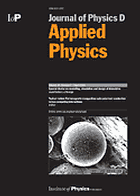|
Literature / Source Database:
Journal of Physics Part D: Applied Physics
Description
The Institute of Physics
| Title (short) |
J. Phys. D: Appl. Phys. |
| CODEN |
JPAPBE |
| Languages |
English |
| First year |
1968 |
| Impact factor |
2.772 |
| Editor |
S.B. Palmer (Univ. Warwick, UK) |
|
|

|
Status
active
Subject

Source type
Journal
Publisher
ISBN ISSN
0022-3727
First volume
1
Last volume
41+
Publish city
Bristol
Homepage
| Resources |
|
Availability |
|
|
|
|
|
| Text PDF |
 |
free access |
 |
| Text Html |
 |
for subscriber |
 |
| References |
 |
not available |
 |
| Abstracts |
 |
|
|
| TOC |
 |
|
|
|
|
|
|

Description
A major international journal reporting significant new results in all aspects of applied physics research. We welcome experimental, computational (including simulation and modelling) and theoretical studies, and also studies in physics-related areas of biomedical and life sciences. Research papers are particularly welcome in the following areas: Applied Magnetism and Magnetic Materials including; - preparation, properties and applications of bulk hard and soft magnetic materials
- preparation, properties and applications of magnetic thin films and multilayers
- nanomagnetism
- spin electronic materials and devices
- magnetic and magneto-optic recording materials and devices
- magnetic sensors and transducers
- computational micro-magnetism, simulation and modelling
- biomagnetism
- molecular magnets
Photonics and Semiconductor Device Physics including; - wide and narrow bandgap properties and applications
- high speed electronic devices
- photonic bandgap structures and metamaterials
- micro and nano structured materials, devices and applications
- MEMS and MOEMS
- single photon sources and detectors
- solid state and semiconductor lasers
- non-linear optics and ultrafast optics
- optoelectronic and electro-optic properties and applications
- displays
- solid state and molecular optical-electronic materials and devices including organic LEDs
- biophotonics, high throughput screening and assay technology
- imaging and detector technology
Experimental, Computational, and Theoretical Particle Beam and Plasma Science including; - low-pressure discharge plasmas
- high-pressure (thermal equilibrium and corona) plasmas
- electron, ion, and neutral particle beam techniques
- homogeneous and heterogeneous plasma chemistry
- waves and instabilities, and dust
- applications in materials processing
- application of generation of coherent and incoherent radiation
- application of waste remediation, and other areas
- application of plasmas to biosystems
Applied Surfaces and Interfaces including; - growth of interfaces, surfaces
- epitaxial growth
- formation of nanostructures, including semiconductors, metals and organics
- nanoscale mechanical properties of interfaces and residual stresses
- surface modification by thermal, plasma and other treatments
- linear and non-linear optical probes for surfaces and interfaces
- interaction of electrons and UV and x-ray photons with surfaces
- surface modification and interface formation by ion implantation
- solid-liquid interfaces
- tribology
- scanning probe techniques; STM, AFM, SNOM
- microscopic control of interface properties
- biological interfaces
- simulation and modelling
Structure and Properties of Matter including; - mechanical, thermal, acoustic and ultrasonic properties of condensed matter
- structure, morphology and growth of solids
- properties and defect structures of thin films
- physics of particulate matter
- biological matter
- dielectric phenomena
- electrical insulation
- metamaterials
Research papers. Reports of original research work; not normally more than 8500 words (10 journal pages). Topical reviews. Timely review articles on an emerging field commissioned by the Editorial Board.
|